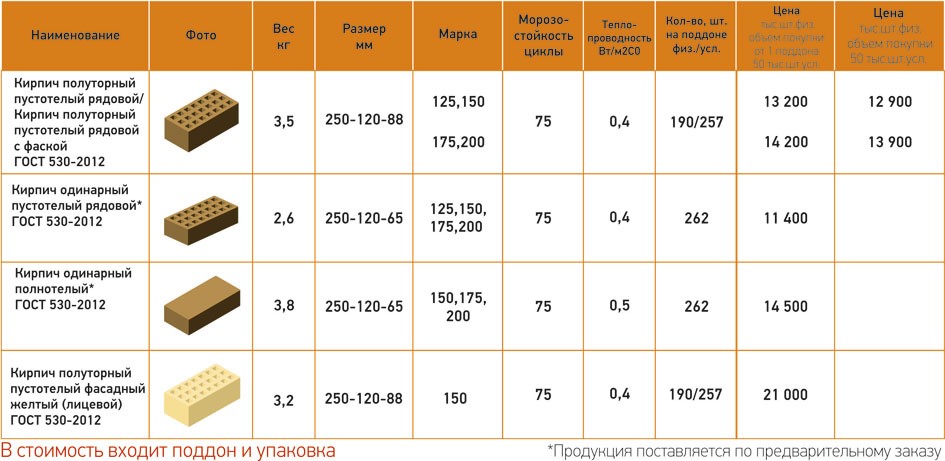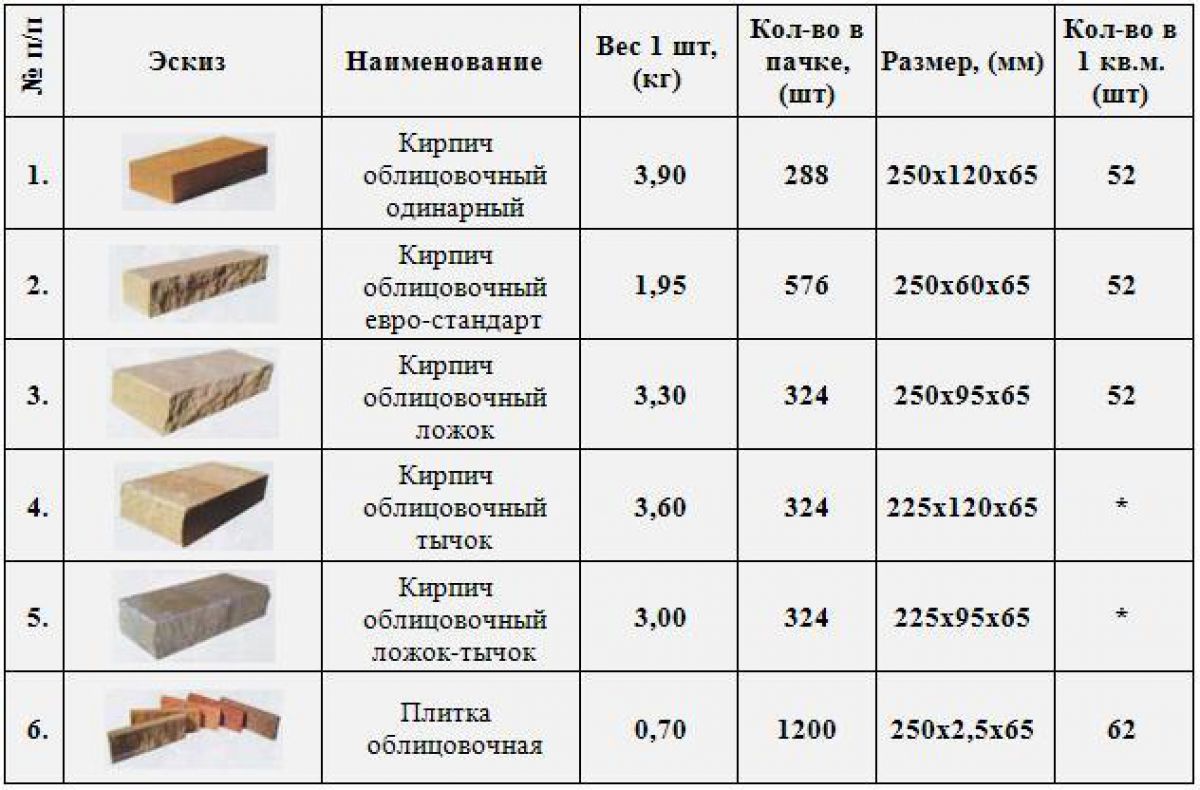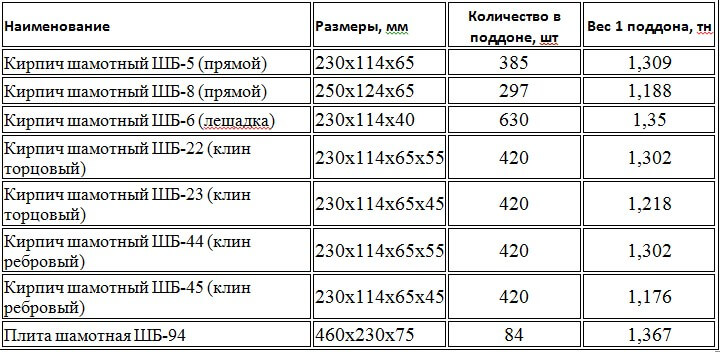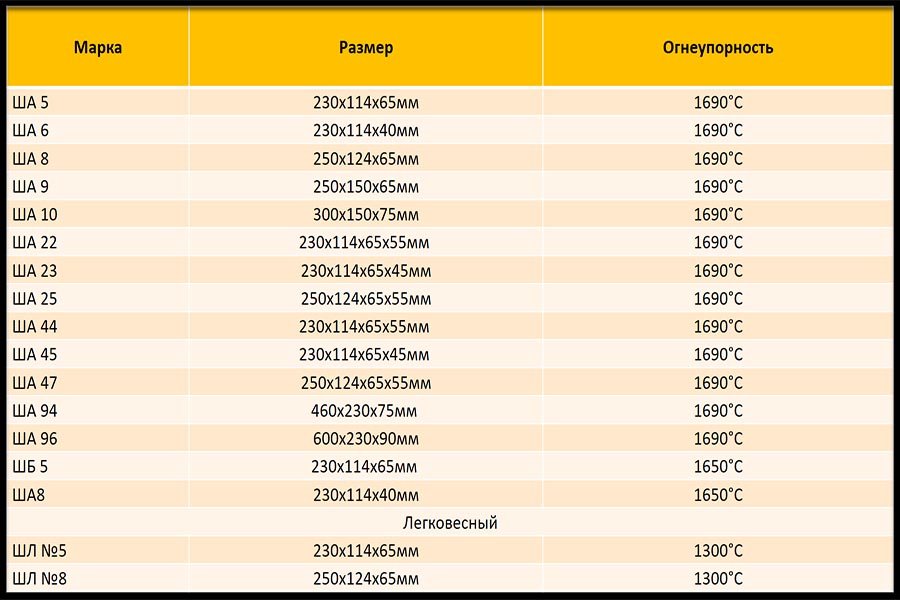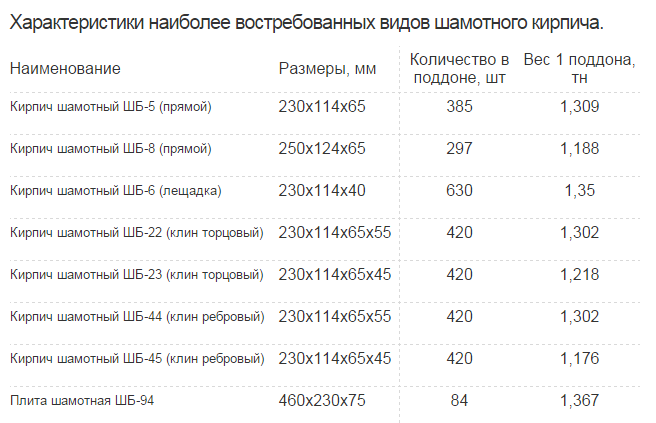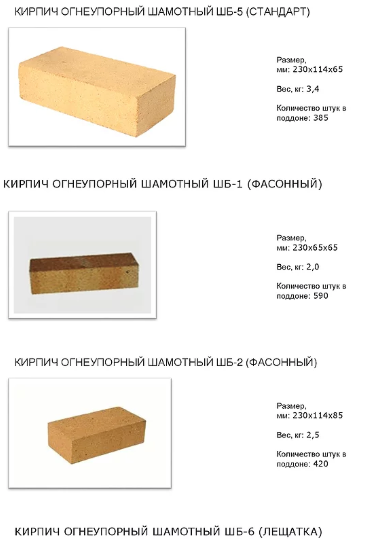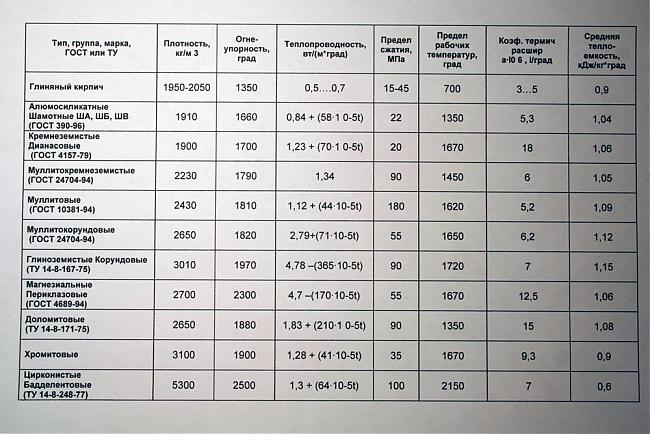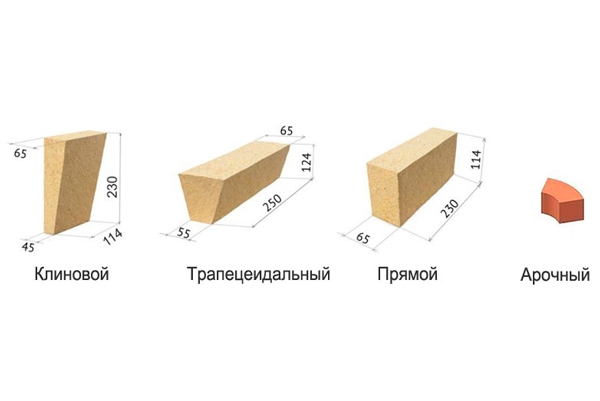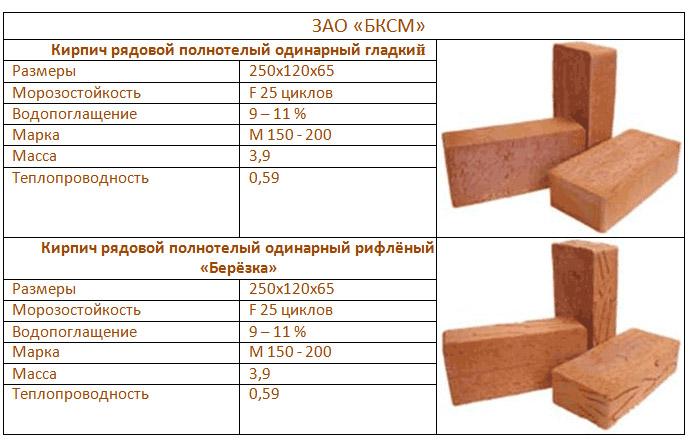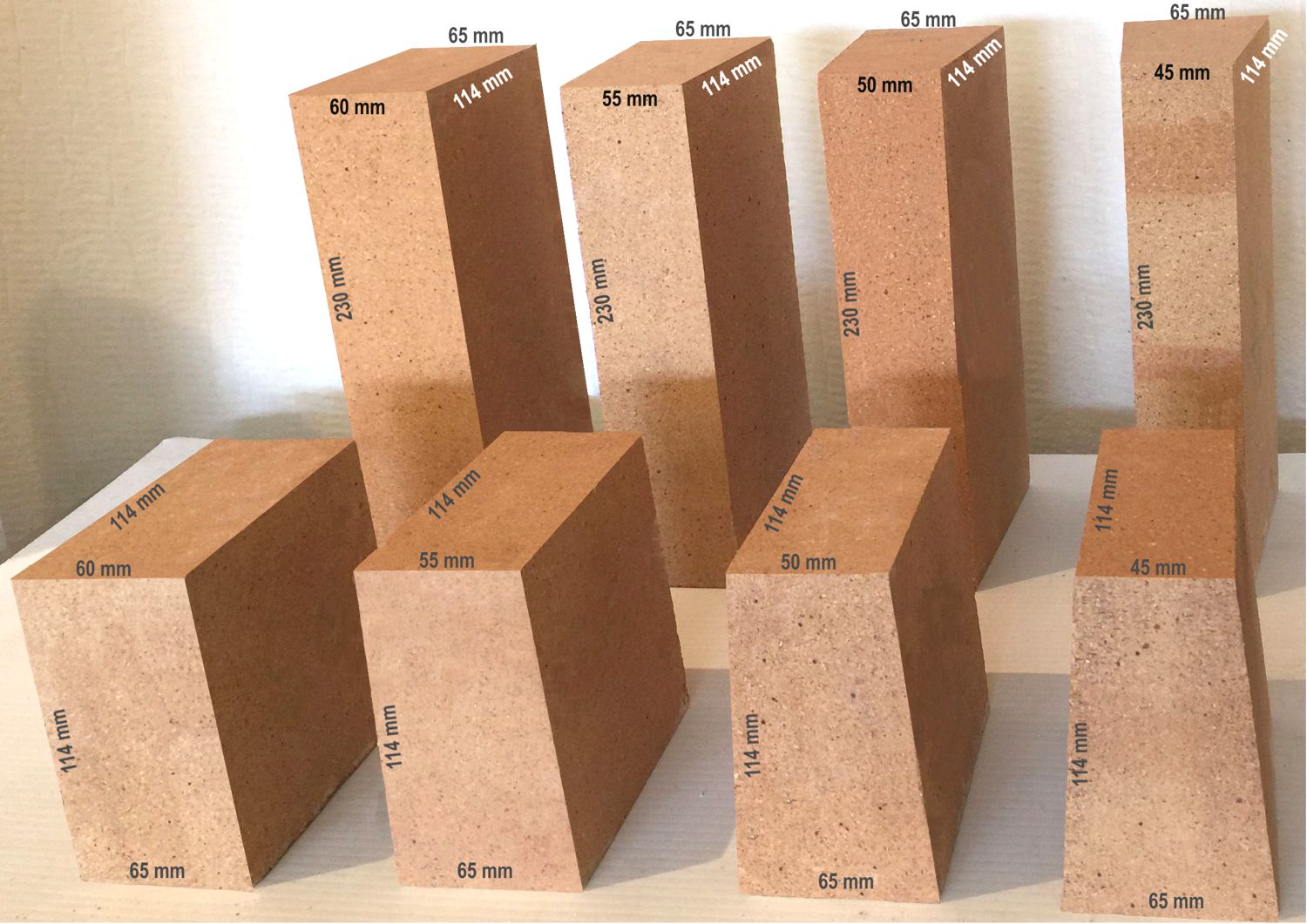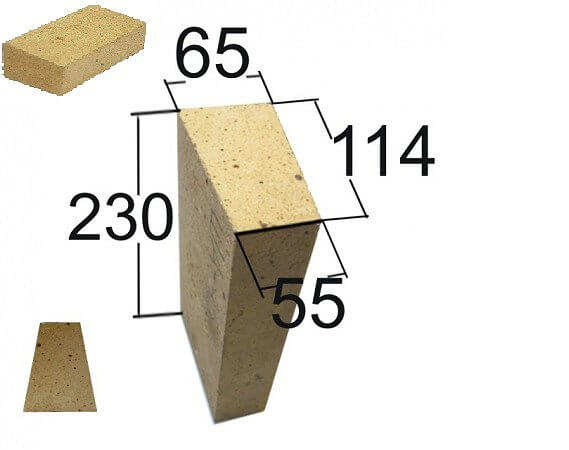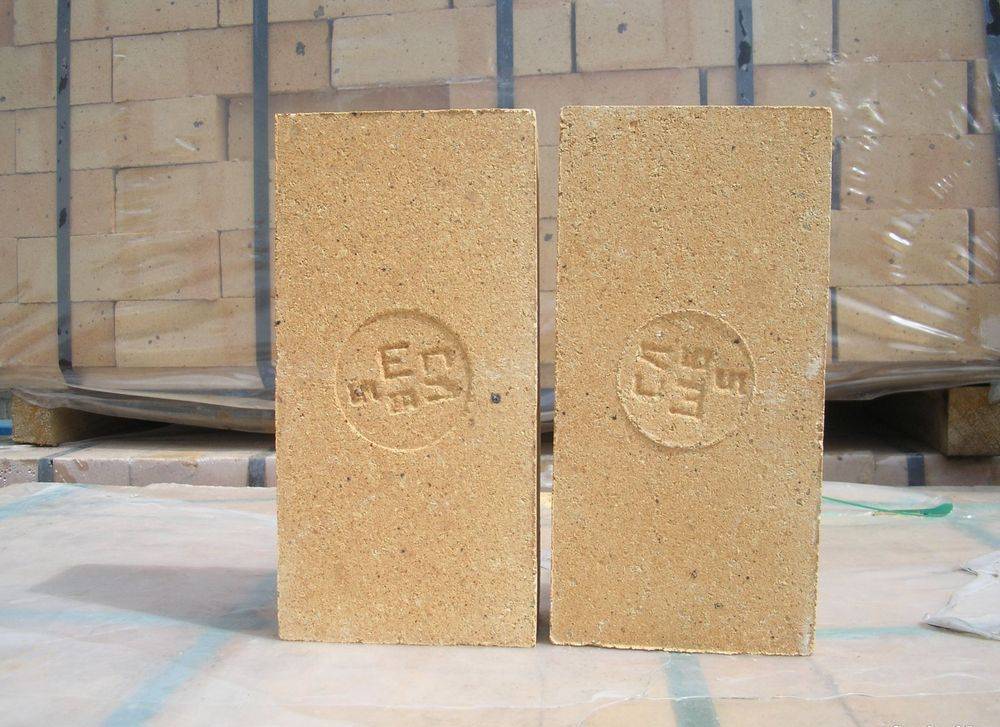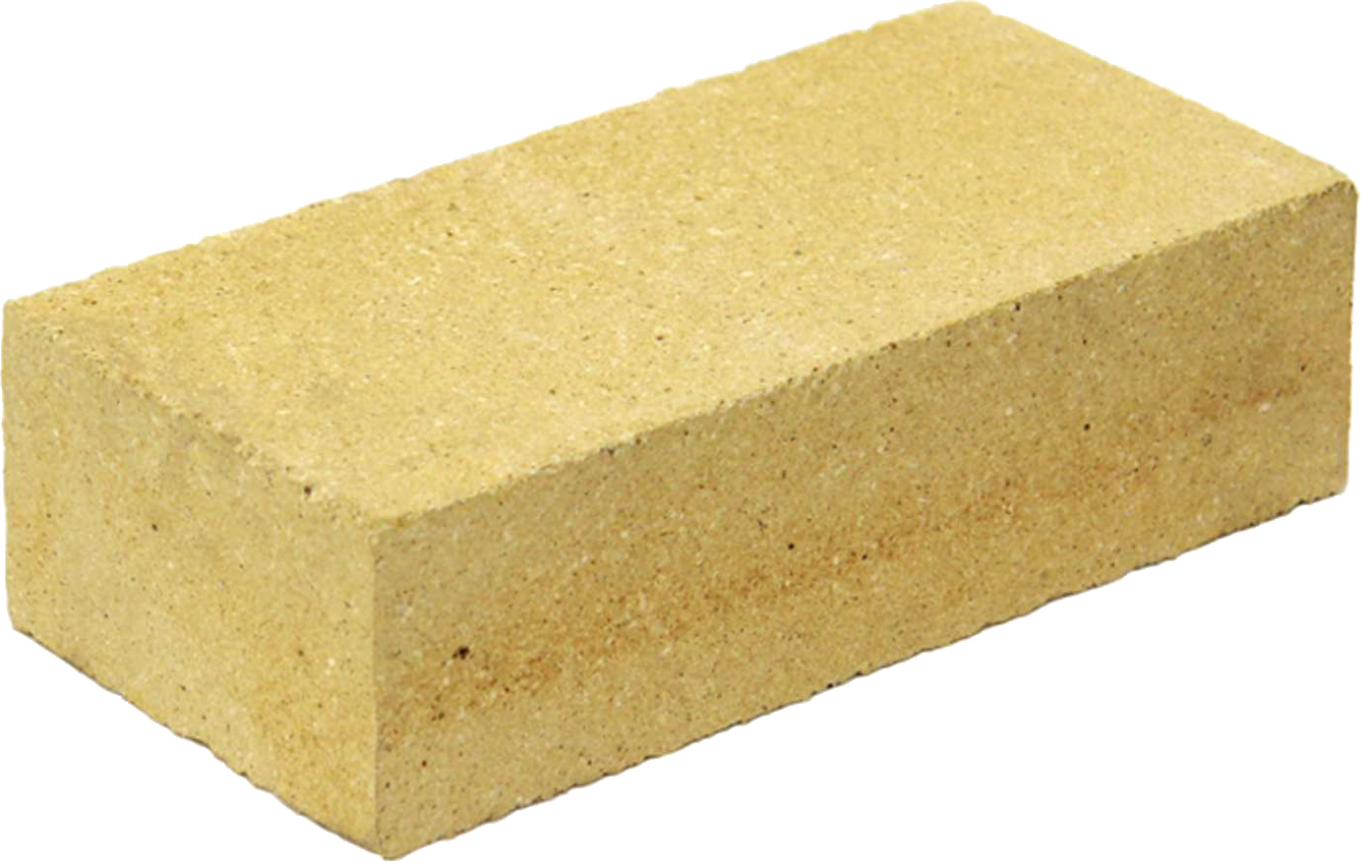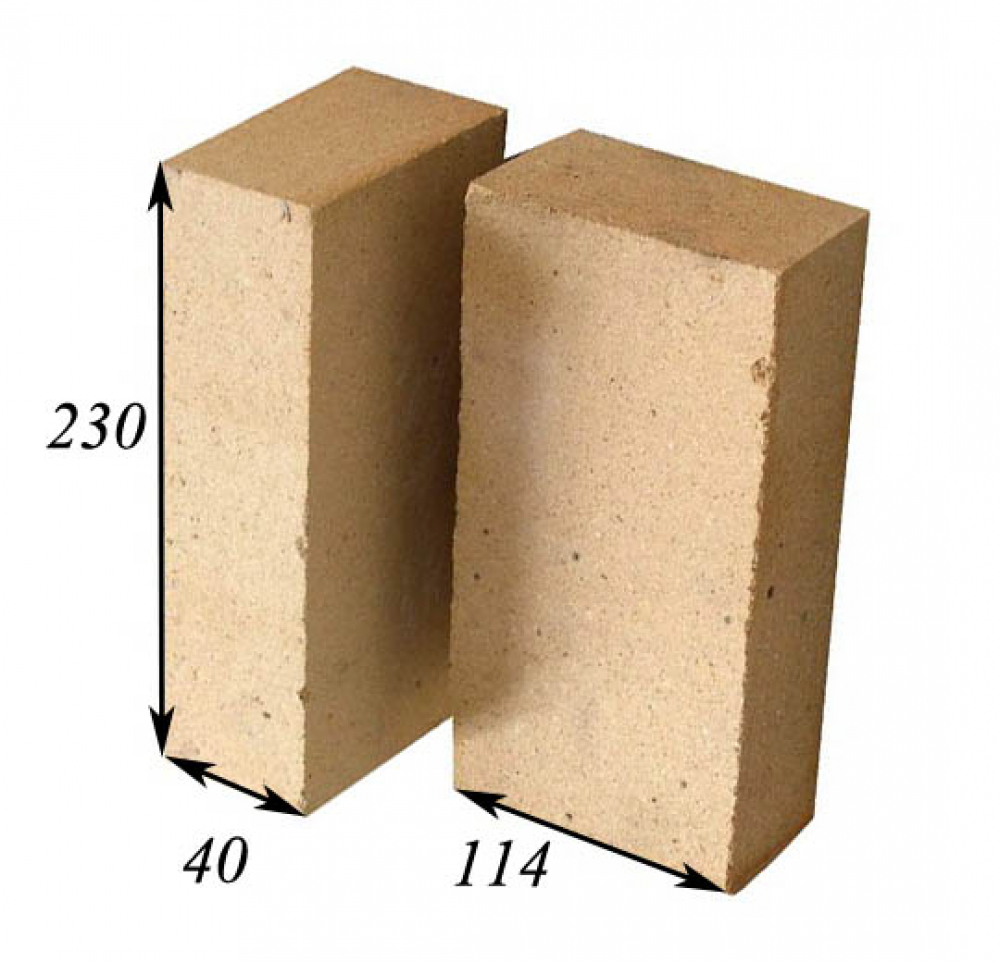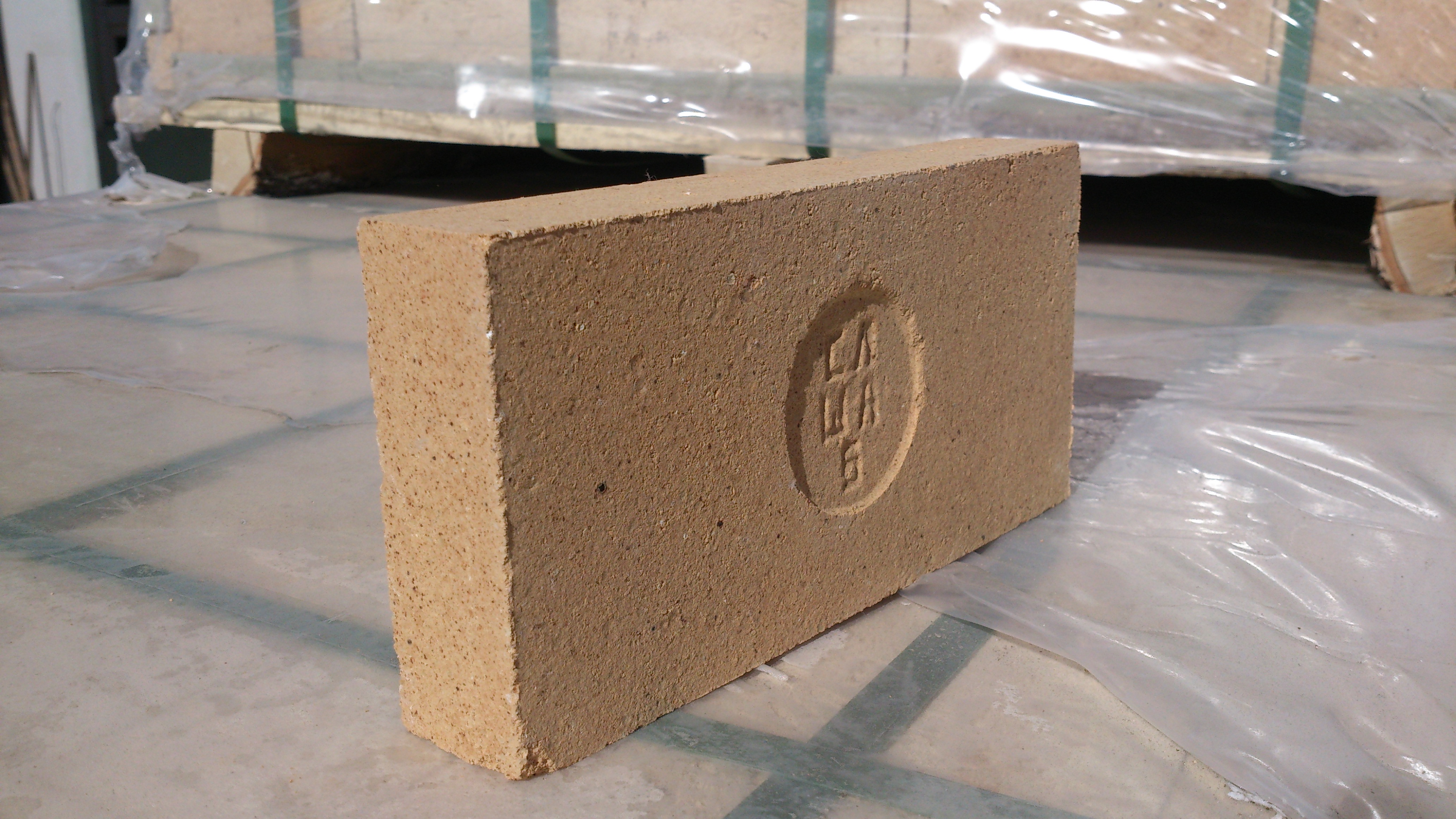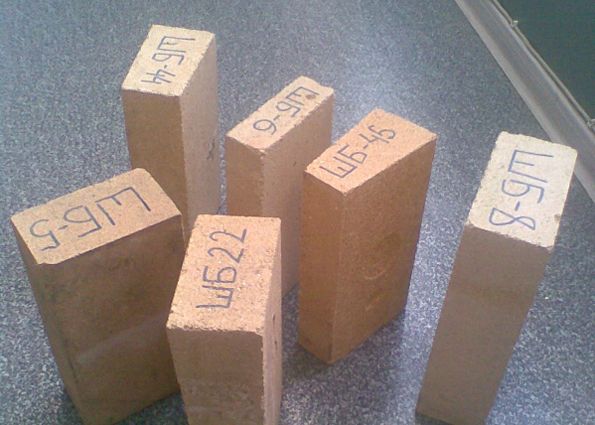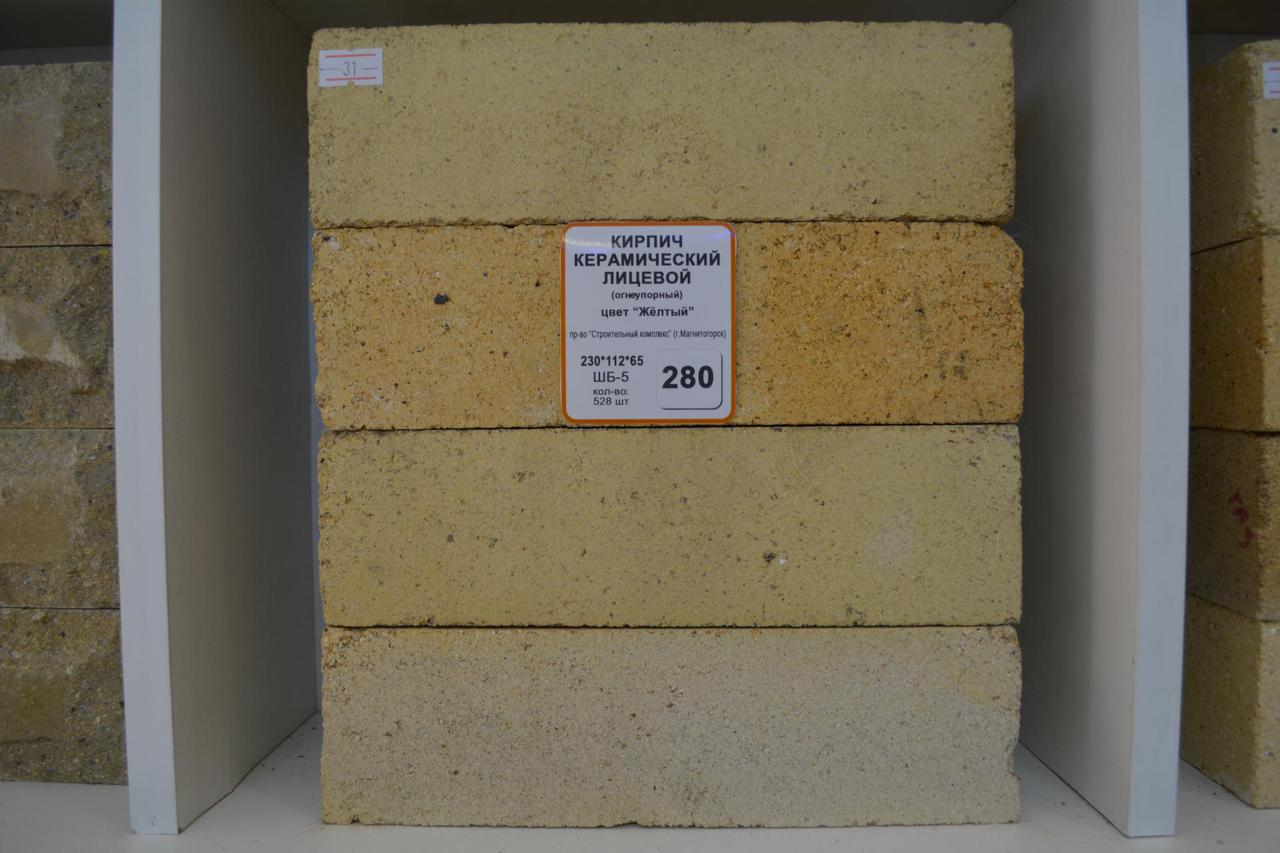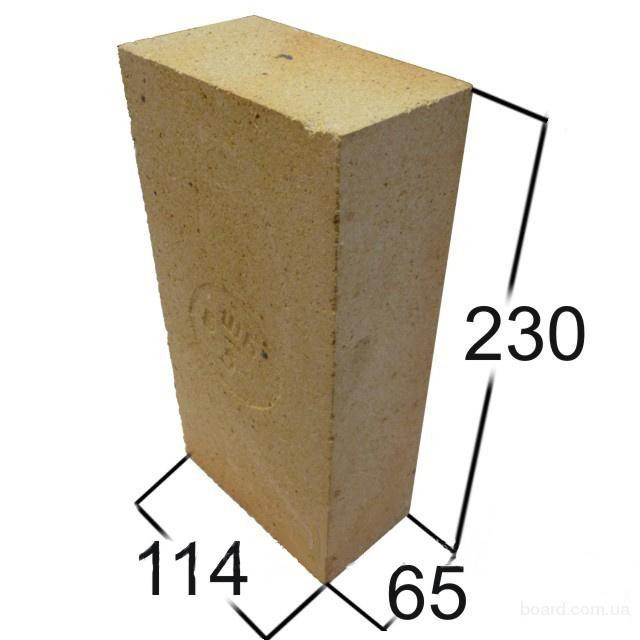Types and marking of fireclay refractory bricks
Fire resistant blocks can be classified according to several criteria:
By molding method
The design of the forms and features of the technological process provide for the following types of molding:
- casting from slips or melts;
- semi-dry forming;
- melting;
- hot pressing;
- thermoplastic pressing.
By block configuration
For the laying of various structures, the industry produces the following types of fireclay bricks:
- wedge-shaped;
- trapezoidal;
- rectangular (straight);
- arched profile.
By chemical composition
Depending on the additives used that affect the thermal stability and mechanical properties, and the characteristics of the production technology, the following modifications of fireclay refractory blocks are distinguished:
- basic. In the manufacture of such bricks, fire-resistant chamotte clay is used, the mass fraction of which in the working mixture is 70%. Coke or graphite powder can be used as a filler. The material is used for facing furnaces designed for melting Bessemer steel;
- carbonaceous. This modification is characterized by a high percentage of carbon. The main purpose of carbon refractory blocks is blast furnace lining;
- quartz. Due to the use of silicon oxide, the heat resistance of bricks is significantly increased, however, contact with an alkaline medium leads to intensive destruction of the material;
- alumina. Aluminum oxide is used as a special additive. Alumina fireclay bricks can work for a long time at temperatures from 1100 to 1300C and are not very susceptible to frequent temperature changes. This type of heat-resistant blocks is widely used when laying household stoves, fireplaces and chimneys.
The marking of fireclay bricks includes letters and numbers that reflect the chemical and physical characteristics and overall dimensions of the material. Below are the markings for the most common modifications.

SHA, SHB, SHAK. The materials have high strength and heat resistance (1600 - 1700C), which allows them to be used in all areas of industrial and civil construction. They contain aluminum silicate, which ensures a long service life and resistance to mechanical damage. Another advantage is the optimal price / quality ratio.
ШВ, ШУС. Brick is widely used in industry. High heat capacity indices allow the use of ШВ and ШУС blocks for the construction of gas channels of steam generators; from such blocks, enclosing structures are erected to protect convection shafts.
ShK. This variety is used for the construction of industrial facilities that produce coke.
SHL. SL brick is characterized by high porosity and low specific gravity. The maximum allowable temperature maintained by the blocks is 1300C. The main area of application is furnace lining.
ShTSU. Double-sided end brick. Most often, rotating elements of the furnaces are laid out from the ShTSU blocks.
PB. This modification is characterized by a high clay content, which significantly reduces the heat resistance of the blocks, but the price of the products is quite affordable for a wide range of consumers.
PV. The products are used for the interior masonry of stoves and fireplaces. PV blocks provide a long period of operation of the masonry and are capable of operating at temperatures up to 1300C. The scope of the material is limited by its high cost.
Scope and method of application
Dimensions of fireclay bricks.
The purpose of the material is, first of all, to withstand high-temperature influences. So the direct scope of its application is furnaces of any type, except for industrial ones, where the temperature reaches 2000 ° C and more. Fireclay bricks, as a rule, are used to lay out the inner part of the firebox, which interacts with an open flame. In technical parlance, this is called a lining.
Refractories are used in the following types of furnaces:
- smelting;
- intended for heat treatment of metals (hardening);
- household heating and cooking;
- fireplaces, barbecue.
It is especially important to lay out the firebox with refractory bricks when burning coal, which gives a temperature above 1000 ° C, from which ceramic products begin to crumble. Some homeowners, having this opportunity, lay out an entire refractory brick oven.
Such decisions have the right to life, but they cannot be called correct.
When lining the firebox of a brick stove, a gap of 20-40 mm is left between the fireclay and red bricks due to the different coefficients of thermal expansion of the materials. Masonry solutions are also used different. For the main masonry, a clay-sand mortar is made of solid red brick. To lay refractory stones, a solution of fireclay clay is used, thereby ensuring the fire resistance of the entire masonry. The width of the seam during the construction of the firebox is observed only 3 mm against 5 mm at the body of the stove.
For fireplaces made of refractory, you can lay out not only the fuel chamber, but also the arch above the opening. To do this, it is not necessary to cut fireclay bricks, wedge-shaped products are sold ready-made. If the design of the fireplace or stove allows you to make the bottom of the firebox thinner, then fireclay tiles of appropriate sizes are used here. The joints between them are also sealed with a solution of kaolin clay.
Advantages and disadvantages of fireclay bricks
Speaking about the undoubted advantage of the fireclay type of material, one can note its ability to retain heat for a long time. Heat transfer from this type of material is slow and due to this, chamotte stoves do not cool down for a long time, storing the heat inside themselves.
However, there are also disadvantages to this type of brick. For example, its ability to quickly gain and retain moisture within itself for a long time. Therefore, fireclay should not be stored outdoors in the open air.
Sizes and types
Furnace alumina SHA-8 has optimal parameters and shape. This is a rectangle with the aspect ratio of length, width and height, respectively: 250 × 124 × 65 mm. The size numbers are almost multiples of each other, which makes it easier to calculate when developing drawings and allows you to lay it in any direction during construction. The SHA-5 brick is the most popular. The size of the brick is 230 × 114 × 65. The difference with the standard is in width. But it is ideally combined with ShB-6 (230 × 114 × 40) and the SHA-1 brand, produced in the form of a bar 230 in length, and 65 mm in width and height. The table shows the dimensions of the main brands of furnace refractory ША / ШБ.
| Size No. | Dimensions, mm | The form |
| 5 | 230×114×65 | Rectangular sophisticated |
| 8 | 250×124×65 | Rectangular standard |
| 6 | 230×114×40 | Rectangular thin |
| 1 | 230×65×65 | Beams |
| 22 | 230×114×65×55 | End wedge |
| 44 | 230×114×65×55 | Rib wedge |
| 51 | 230*114*56*65 | Trapezoidal transverse double-sided |
| 74 | 230*30*230*115 | Window |
| 78 | 25*25*160*2 | Pivot suspended ribbed |
A significant number of forms allows you to diversify the configurations of heating devices. Direct is used for laying the stove and chimney. Wedge (rib and end), trapezoidal, suspended - suitable for creating vaults and arches. Depending on the shape, the standard size also differs. It grows in ascending order within the format. The size of the refractory brick is an important material selection criterion. The quality and durability of the structure depends on the accuracy of the fit.
Types of fireclay bricks, technical characteristics in accordance with GOST (weight, size) and how it differs from ordinary red
Fireclay brick is a type of ordinary refractory brick, which is made using clay and special powder.
Then the bricks in the molds are sent to the kiln, where they are fired (as well as ceramic ones) under the influence of very high temperatures. If we talk about the sizes of fireclay bricks, then they are described in detail in GOST under the number 8991-73. Naturally, the size of fireclay bricks depends on its specific type.
Let's consider the main of these markings.

Chamotny
Fireclay bricks ША and ШБ differ from each other in composition and size.
Within this marking, there are varieties with certain sizes. ShB bricks are characterized by a slightly lower heat resistance - about 1650 degrees. As for other characteristics, they are completely identical with the SHA marking bricks.
SHA-5
The size of (silicate) fireclay bricks ША-5 is 23 × 11.4 × 6.5 cm.One pallet holds 380 pieces. At the same time, the weight of one brick is about 3.5 kilograms.

SHA 5
Bricks of this brand are widely used in the construction of household stoves and fireplaces.
SHA-6
Bricks of the SHA-6 brand differ in that they are narrower in comparison with other brands.

SHA 6
Their dimensions are 23 × 11.4 × 4 cm. As for the other characteristics, they completely coincide with the bricks of the SHA-8 brand.
Refractory SHA-8
Bricks of this brand are widely used for private and industrial purposes. The proportion of aluminum oxide in their composition is at least 30 percent.
The products can withstand temperatures of 1690 degrees Celsius. At the same time, the temperature at which the brick begins to soften is about 1300 degrees.

SHA 8
The bricks of this brand are large when compared with the SHA-5 and SHB-6 brands, therefore it is advisable to use them in the case when the construction must be carried out in a short time.
ShB-5
Fireclay brick ШБ-5 has the following dimensions - 23 × 11.4 × 6.5 cm.

SB 5
Refractoriness is also inferior to the SHA-5 grade - it is about 1650 degrees Celsius. The weight of one product is three and a half kilograms.
In addition to the previously mentioned markings of fireclay bricks, which can be considered one of the most popular, there are many other varieties of this refractory material.
For example, the SHA brand has a large list of different varieties:
SHA-2. Such a brick has dimensions of 23 × 11.4 × 6.5 cm;

SHA 2
SHA-9. The dimensions of this brand are 30x15x6.5 cm;

SHA 9
SHA -10. The dimensions are as follows - 34.5x15x7.5 cm.

SHA 10
Separately, I would like to talk about fireclay wedge bricks. We are all accustomed to the fact that a brick has a standard rectangular shape, but various construction tasks impose additional requirements on the shape of this product.

Stamps
For example, if you need to build various arches of a semicircular size, or other buildings with a certain curvature, then the following types of fireclay bricks will come in handy:
- SHA-22. This end wedge has the following dimensions - 23 × 11.4 × 6.5 × 5.5 cm;
- SHA-23. This wedge has the following dimensions - 23 × 11.4 × 6.5 × 4.5 cm;
- SHA-24. This wedge also belongs to the end wedge category. Its dimensions are as follows - 25 × 12.4 × 7.5 × 5.5 cm;
- SHA-44. This wedge belongs to the ribbed category. The overall dimensions are as follows - 23 × 11.4 × 6.5 × 5.5 cm;
- SHA-45. This rib wedge has the following dimensions - 23 × 11.4 × 6.5 × 4.5 cm;
- SHA-46. The dimensions of this wedge are as follows - 25 × 12.4 × 7.5 × 5.5 cm.
For more information about the dimensions of fireclay bricks, see the video:
Types and sizes of oven bricks
When constructing a furnace, it is important to ensure such parameters as a long service life, high heat transfer rates, and optimal dimensions of the furnace. To achieve them, it is recommended to use a special oven brick.
When choosing it, it is important to take into account not only dimensions, but also physical properties. When the blocks have the correct shape, size, do not have any deviations in terms of appearance, and also provide good traction, then be sure that the built stove will serve you efficiently and for a long time.
Which brick is best to use for the oven. For the construction of a furnace, a suitable material is ceramic (the pros and cons of ceramic bricks are described here), grade M-150. But it is much better when the masonry of the structure is made from materials from several manufacturers. Single refractory bricks can be of several varieties.Each species has its own size, weight and physical properties.
The video tells about the dimensions of the oven brick:
This product is based on alumina materials. They make up 70% of the total composition. When buying such a product, you must be guided by the following recommendations:
- Tap a little and determine its quality by the sound. If you hear a metallic sound, the test item is solid.
- You can determine the quality of a product by its color. If it is a faded shade, then it does not fit.
- Hit the brick hard to make it fall apart. If during this process dust has formed, then the product is of high quality.
- If the surface of the material has a glassy coating, then this indicates that it has been severely burned out. During the construction of the furnace, such a brick will not provide adhesion.
- Using a hammer, break the product into 2 parts. If the color inside becomes darker, then this indicates that the sample is burnt.
Facial red and double silicate
Observance of geometry is very important for the first type. Such material is always sold in a wide variety of shades and colors.
As for double sand-lime brick, when choosing it, it is important to take into account the degree of heating of the future structure.
See a photo of panels for the kitchen with a picture.
Clinker
This material is one of the most versatile. It is allowed to be used for laying the stove both inside and outside the house. It has the following advantages:
- shock resistance;
- high environmental friendliness;
- attractive appearance;
- wear resistance;
- not subject to temperature differences;
- waterproofness.
- long-term operation;
- the brick is able to "breathe".
The process of making refractory in Russia began to be introduced back in the 19th century. At that time, steel was being actively melted. But the melting process must take place at high temperatures. To solve the problem, it was necessary to use a material that could withstand such a temperature regime. Refractory brick production is based on refractory types of refractory clay.
Also, it is distinguished for the masonry of the furnace by the components that make up its composition.
So, the following materials are distinguished:
- Fireclay bricks contain a large amount of clay. The ease of obtaining the product made it possible to acquire the product in great demand in the construction market. It is actively used when laying stoves inside the house. To impart porosity to the brick, aluminum oxide is added to its composition. The lighter the brick, the more efficiently it conducts heat energy. With high-quality fired fireclay brick, it is possible to obtain a yellow tint. Here you can see the weight of fireclay bricks.
- Quartz is obtained by combining chamotte and quartz sand. It is used where there is a direct effect of fire. It has a granular structure. In the photo - quartz brick:
- The main brick is obtained by using fire-resistant lime-agnium masses.
- The carbonaceous material is pressed coke or graphite, which is actively used in the construction of blast furnaces.
Refractory bricks
Ordinary building bricks, depending on the raw materials used in its production, are divided into:
- Ceramic - which is made from clay.
- Silicate - it uses a mixture of sand and lime, other additives.
But, these products of brick production can not be used everywhere. For example, with high-temperature technologies (up to 1800 degrees C) in the metallurgical industry, in the glassmaking (glassmaking) industries, the same ordinary clay brick (in common people, "red") will not withstand high temperatures for a long time.
With extreme heat and prolonged exposure to high temperatures, it will begin to melt, and then, cooling down, it will crumble.Although, as a masonry and finishing material, it is widely used in indoor fireplaces and stoves of baths, saunas, living quarters, where the temperature is not higher than 800 degrees C.

Variety of refractory structures and elements
Types of fire resistant building materials
In furnaces where glass is blown, porcelain is fired, in blast furnaces where steel is melted, a more resistant, fire-resistant material is used in the furnace core. Refractory bricks in accordance with GOST 8691 - 73 can withstand heat with a temperature of more than 1000 degrees C.
Refractories are produced with different properties and characteristics for different applications.
Fire-resistant material according to its physics - chemical composition, production methods and methods, temperature range is divided into four classes:
Composition and fields of application of refractories
- Quartz brick - consists of quartz (sandstone), with small additions of clay. As a result of firing, it acquires a cavity-free, full-bodied structure. In fireboxes, it is used in places where it has contact only with an open flame (for example, reflective arches in fireboxes, fireplaces, stoves). Stores accumulated heat well.
Important to remember! Quartz refractories should not have contact with alkalis, lime, iron oxides, which destroy it

- Carbonaceous - in a simplified form, it is compressed graphite or coke. It has the highest strength and fire resistance characteristics. It is used in highly specialized areas of construction (for example, in the construction of blast furnace structures).

- The main one - includes a lime-magnesian mass in its composition, which makes it possible to use this refractory for the production of Bessemer steel from phosphorous ores.
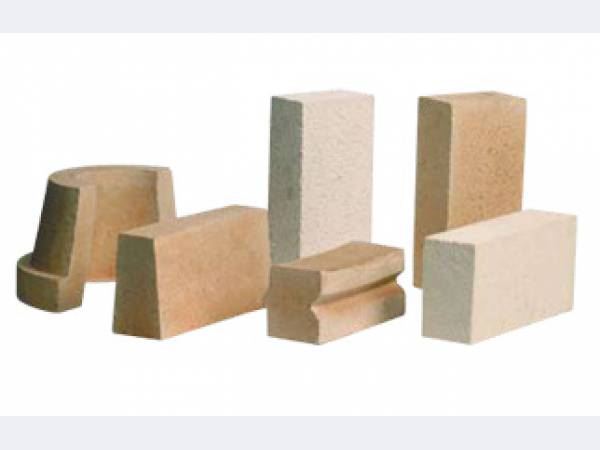
- Alumina - from its very name it is clear that in its basis clay makes up most of the structural component (about 70%). Therefore, it better (in contrast to quartz refractories) resists the destructive action of alkalis (lime). Easily tolerates rapid temperature changes.
It is easy to manufacture, and its price is lower than other flame retardant materials. It is widely used in the cores of furnaces, where the temperature is not higher than 1300 degrees C. Bricks of this type are also called "fireclay". It is marked with the letter "Ш", and the numbers following it carry information about its dimensions.
Designation, shapes and sizes of fireclay products (GOST 390-96, GOST 8691-73)
The size and shape of the refractory brick may vary. According to GOST alone, there can be more than a hundred such standard sizes.
Therefore, we will present only the most used products in private furnace construction. The rest can be found in the standards themselves.
The brand of building material depends on the maximum temperature of its application during operation.
Table: Limiting temperatures for the use of fireclay products
Refractory grade
Tables: Wedge chamotte
Thus, chamotte products for standardization are divided into:
- wedge or straight (normal sizes),
- large or small formats;
- shaped large-block, especially complex, complex, simple;
- special fireclay products for industrial and laboratory use.
Weight characteristics of refractory (fireclay) brick GOST 390 - 96
The weight of refractory bricks depends on the raw materials from which it is made, on its shape and size. How much does the fireclay brick of the most popular brand (ША, ШБ) weigh, and its packaging (cages) without taking into account the mass of the pallet 30 - 40 (kg), see the table below
Specifications
During the operation of the furnace, fire and the products of its combustion directly affect the refractory brick. Moreover, its contact with acids, alkalis, and other aggressive media is practically zero.
Accordingly, the manufacturer and the buyer do not impose any special requirements for the durability of the material.
Due to its technical characteristics, fireclay bricks are not recommended to be purchased for the construction of structures that will be in direct contact with acids and other representatives of an aggressive environment.
Moisture accumulation
Fire-resistant material is produced on the basis of clay, which is fired, and as a result changes its structure (the brick becomes porous).
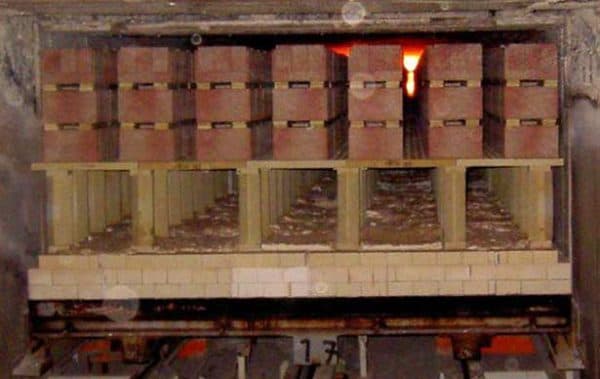
Kiln firing
The voids in the brick itself contribute to the insignificant accumulation of moisture that occurs during contact with water. Porous heat-resistant bricks can accumulate forty percent moisture. This feature of the fire-resistant material must be taken into account during warehousing and storage.
Frost resistance and fire resistance
Products where heat-resistant bricks are used, due to their design, are distinguished by high frost resistance and fire resistance. According to current regulations, these characteristics are assessed by the ability to withstand the specified freeze and thaw cycle.
Let's pay attention to the indicators SHAK, SHA, B and B. In this case, they cannot be more than 15 cycles
Refractory material should not be used in the construction of basement structures. Also, it is not suitable for outdoor cladding.
When a building is provided with stove heating, it is necessary to always maintain a positive temperature. Cooling down to extremely low temperatures on a regular basis will affect deformation and possible fracture.
Refractory materials of various types are presented on the market in 11 standard sizes, each of which stands out for its length, thickness and height.
| Number | |||||||||||
| 1 | 2 | 3 | 4 | 5 | 6 | 6 a | 7 | 8 | 9 | 10 | |
| D | 23 | 23 | 23 | 23 | 23 | 23 | 23 | 25 | 25 | 30 | 34.5 |
| T | 6.5 | 6.5 | 11.4 | 11.4 | 11.4 | 11.4 | 15 | 12.4 | 12.4 | 15 | 15 |
| V | 6.5 | 6.5 | 10 | 7.5 | 6.5 | 4 | 6.5 | 7.5 | 6.5 | 6.5 | 7.5 |
Refractory bricks of different types can have maximum deviations:
- length. An error of no more than 0.5 cm is allowed;
- width. An error of no more than 0.3 cm is allowed;
- thickness. An error of no more than 0.1 cm is allowed.
Before entering the market, finished products must undergo control of manufacturing accuracy, as well as conformity of shapes. For this, special independent departments are being created at the enterprises. Products are checked selectively from each batch produced.
Strength indicators
Special fire resistant bricks will resist these factors. The strength of all future products is based on strict adherence to technological standards and recipes. The admissible maximum strength stands out for fireclay bricks. The indicator of the SHAK brand is equal to twenty-three N / mm 2.
Such material is often used for masonry of household and technological structures at industrial facilities. It is also often purchased for arranging fireplaces and stoves. When a buyer chooses a certain brand of brick, it is strength that plays a decisive role here.
Indicators of exposure to temperatures
When firing, chimney ducts and pipes cannot do without high-temperature combustion products. Therefore, the materials used that are purchased for the construction of the structures described above must be characterized by increased temperature standards.
The requirements that the materials of other components of the stove or fireplace must meet are not so stringent. So, a brick for a chimney can withstand up to six hundred degrees Celsius.
What is fireclay refractory brick? Types and characteristics
What a fireclay brick is is known to everyone who has at least once equipped a solid stove in a bathhouse or a fireplace in their home. But for beginners who are just learning these basics, it is worth taking a closer look at such an unusual material. Today we will look at the main types of furnace blocks, their properties and determine the standard sizes.

Composition and characteristics
Like traditional ceramic, refractory bricks are made from clay, not ordinary red, but yellow fireclay. Stones, 2/3 consisting of it, belong to alumina types of heat-resistant materials. They are not only able to withstand extremely high temperatures, but also resist deformation under pressure in such difficult conditions.Fireclay bricks are fired at +1300 ° C (ceramics are sintered at +1100 ° C). And in the course of its further operation, it calmly endures prolonged contact with open fire. It acquires other positive characteristics thanks to additives: graphite, crushed quartz, coke and various oxides.
Basic properties and technical characteristics of fireclay bricks made according to GOST:
- Compressive strength - 15-23 N / mm 2.
- Thermal conductivity - 0.84-1.28 W / m ° C.
- The average operating temperature is not less than +1350 ° С, although the actual indicators of refractoriness are much higher and reach +1730 ° С.
- The average weight of a single brick is 3.7 kg. Products manufactured according to TU can have a mass of 2.5-6.0 kg.
- Chemical resistance to alkalis and acids.
- Water absorption (for dense materials) - at the level of 7%.
The main component that manufacturers add to the refractory mixture is alumina. It increases the mechanical strength of the blocks and their resistance to aggressive substances. In addition, the content of Al2 O3 affects the porosity of the finished material, and hence its heat capacity. Therefore, a classification of refractories was introduced in terms of voidness, according to which fireclay bricks are divided into eight groups - with the ratio of internal pores to the total volume from 3 to 85%. But in this case, it is worth adhering to the golden mean, because stones with a small specific gravity noticeably lose in strength.

Light brick (SHL or SHLT) has a slightly different composition, since organic components such as peat or sawdust are included to obtain high voidness values. After firing, they simply burn out, leaving pores of the appropriate size in the body of the stone. The main characteristics of a refractory brick of the SHL brand:
- Density - 0.3-0.9 t / m 3.
- Compressive strength - 1.0-3.5 N / mm 2.
- Thermal conductivity - 0.2-0.7 W / mK.
- Refractoriness - +1300 ° C.
Despite their low weight, such products are capable of operating at very high temperatures, but they are mainly used only as thermal insulation for furnaces and hot units (steam pipelines, boilers). Private developers should buy lightweight refractory bricks to reduce energy costs for heating. With its help, you can reduce the heat loss of heating devices and save from 10 to 45% of fuel.


